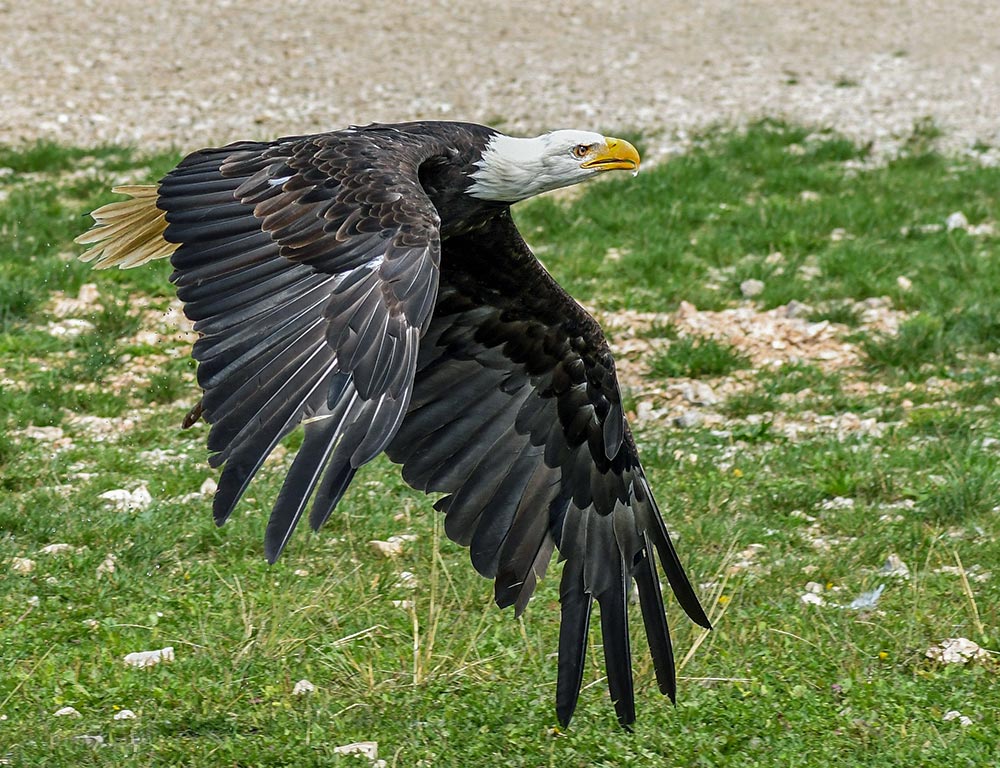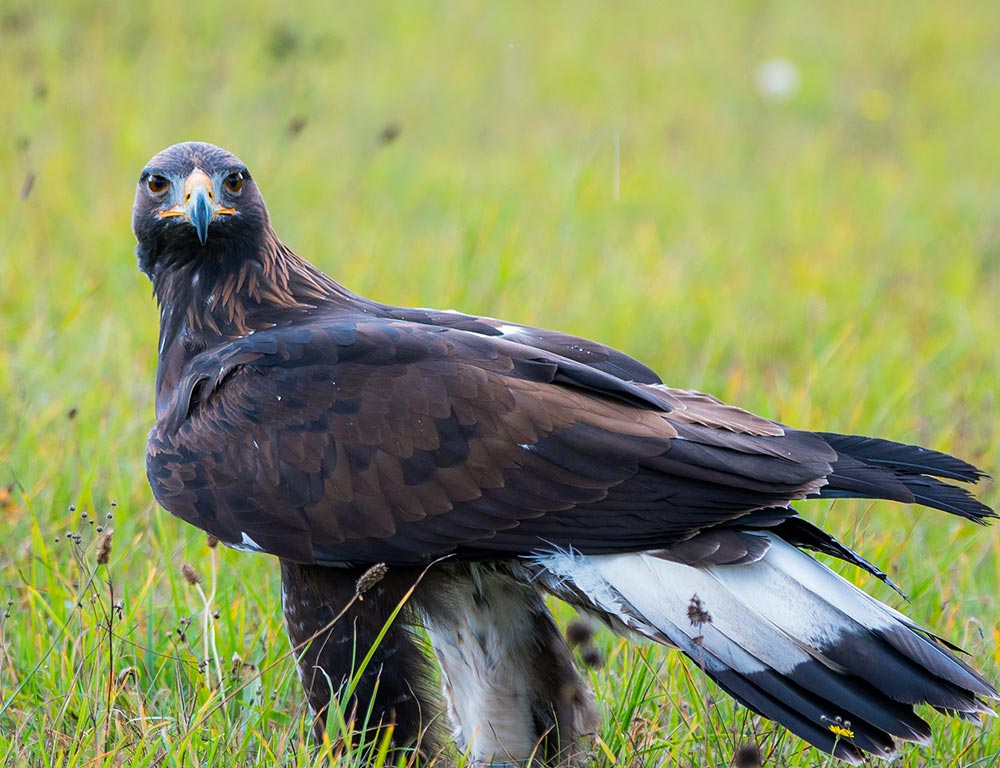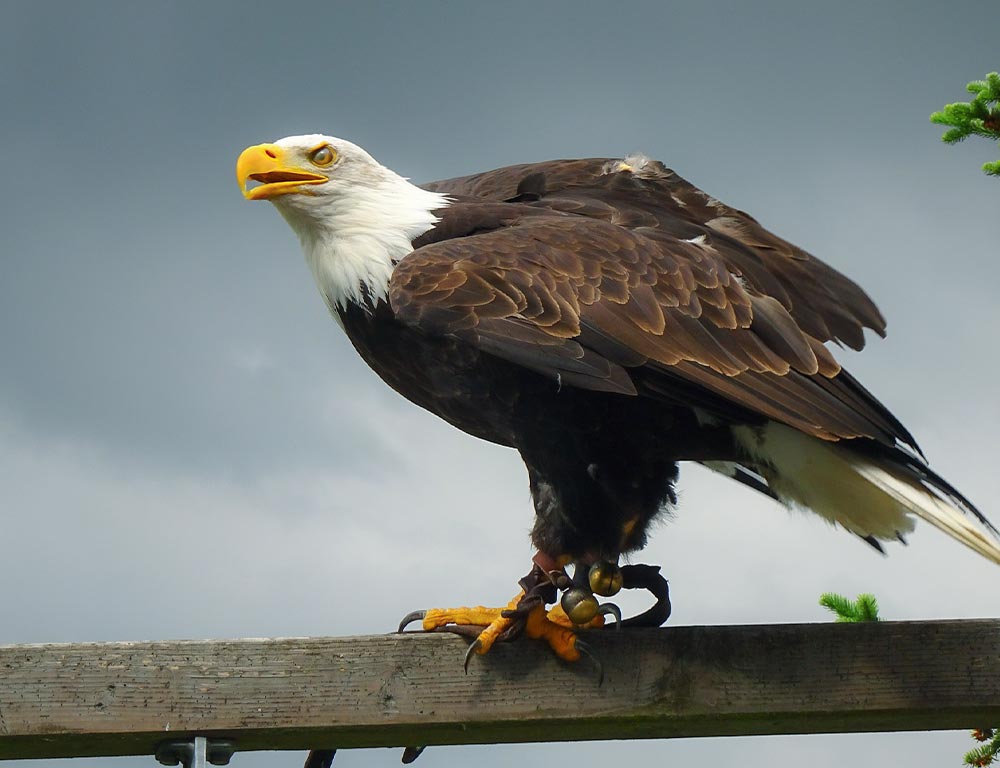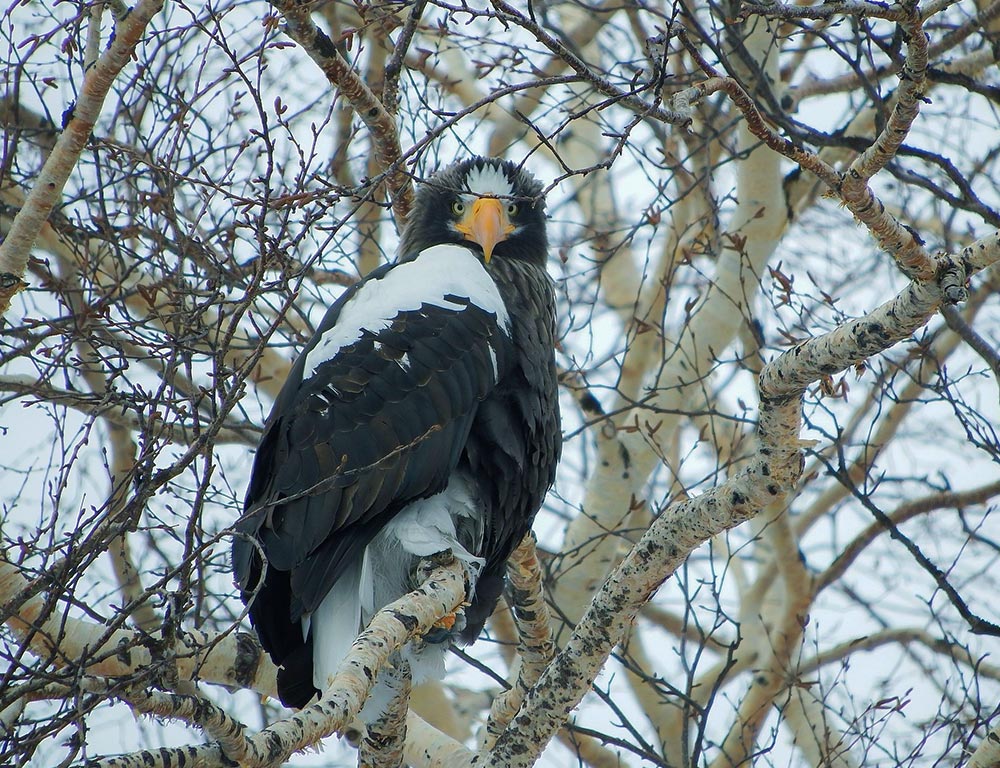Alaska is home to four mighty eagle species, each commanding the skies with grace and power. The Bald Eagle, recognized as the national symbol, shares its vast wilderness with the Golden Eagle, Steller’s Sea Eagle, and the White-tailed Eagle.
These majestic raptors play pivotal roles in Alaska’s intricate ecological tapestry, showcasing the state’s unique biodiversity. With pristine landscapes offering ample hunting grounds and nesting sites, these eagles thrive in Alaska’s rugged beauty.
Observing their soaring flights against the backdrop of icy fjords and towering mountains highlights their significance in this untamed wilderness.
As apex predators, these eagles contribute to the delicate balance of nature, embodying the spirit of the Last Frontier and symbolizing the resilience of wildlife in one of the most remote and awe-inspiring regions on Earth.
Is Alaska A Good Place for Eagles?
Indeed, Alaska is an exceptional habitat for eagles, offering an unparalleled environment that caters to the needs of these majestic birds of prey.
Here are five descriptive points highlighting why Alaska is a prime location for eagles:
Abundant Fish Resources
Alaska’s rivers and coastal waters teem with a rich variety of fish, providing an abundant and reliable food source for eagles. The state’s pristine waterways, such as the Yukon River and Bristol Bay, create ideal conditions for these raptors to thrive.
Varied Ecosystems
From rugged mountains and dense forests to expansive tundra, Alaska’s diverse landscapes offer eagles a range of habitats for nesting and hunting. This ecological variety allows eagles to adapt to different environments throughout the state.
Seasonal Salmon Runs
The annual salmon runs in Alaska’s rivers attract a significant concentration of eagles during the summer and fall.
Eagles gather to feast on the spawning salmon, creating impressive displays of aerial prowess and providing unparalleled opportunities for observation.
Sparse Human Disturbance
Much of Alaska’s vast wilderness remains relatively untouched by human development.
This limited human disturbance is crucial for eagles, allowing them to nest, hunt, and flourish without the disruptions often associated with more populated areas.
Migration Crossroads
Alaska is a vital crossroads for migratory routes of various bird species, including eagles.
The state’s strategic location makes it a key stopover point during both spring and fall migrations, further contributing to the diversity and abundance of eagles.
Alaska’s combination of abundant food resources, diverse ecosystems, seasonal phenomena like salmon runs, limited human disturbance, and its role as a migration hub make it an outstanding and thriving habitat for eagles.
The state’s vast and untamed wilderness provides an ideal setting for these iconic birds to fulfill their ecological roles and captivate observers with their awe-inspiring presence.
4 Types of Eagles In Alaska
Alaska, a haven for majestic eagles, hosts four formidable species: the iconic Bald Eagle, the powerful Golden Eagle, the imposing Steller’s Sea Eagle, and the regal White-tailed Eagle.
These magnificent birds command the Alaskan skies, embodying the wild beauty of this northern wilderness.
1. Bald Eagle

- Scientific Name: Haliaeetus leucocephalus
- Life Span: Up to 28 years in the wild
- Size: 28-40 inches (length)
- Weight: 6.5-14 pounds
- Food: Mainly fish, birds, and small mammals
- Wingspan: 6.1 to 7.0 feet
- Status: Least Concern (Protected under the Bald and Golden Eagle Protection Act)
The Bald Eagle, a symbol of strength and freedom, is an iconic resident of Alaska. With its distinctive white head and tail, it thrives near coastal areas and large bodies of open water.
Bald Eagles boast a remarkable lifespan of up to 28 years in the wild. Their substantial size, ranging from 28 to 40 inches and weighing 6.5 to 14 pounds, make them formidable predators.
Feeding primarily on fish, Bald Eagles also consume birds and small mammals. Their powerful talons and hooked beaks aid in hunting and catching prey. These raptors build large nests in trees near water, contributing to their survival and reproductive success.
Classified as “Least Concern,” the Bald Eagle is protected by legislation, ensuring its continued presence and conservation in Alaska’s diverse ecosystems.
2. Golden Eagle

- Scientific Name: Aquila chrysaetos
- Life Span: Up to 30 years in the wild
- Size: 27-33 inches (length)
- Weight: 6.6-15 pounds
- Food: Mainly mammals, including rabbits and ground squirrels
- Wingspan: 6.0 to 7.5 feet
- Status: Least Concern
With its golden-brown plumage, the Golden Eagle is a majestic and versatile predator in Alaska. These true eagles thrive in various habitats, from mountains to grasslands.
Golden Eagles exhibit remarkable lifespans of up to 30 years in the wild. Their size, ranging from 27 to 33 inches in length, and a weight varying between 6.6 to 15 pounds, showcases their adaptability.
Predominantly carnivorous, Golden Eagles primarily feed on mammals, favoring rabbits and ground squirrels.
Their strong talons and sharp beaks make them adept hunters. Golden Eagles build large nests on cliffs or elevated locations for nesting and raising their young.
Classified as “Least Concern,” the Golden Eagle’s stable population in Alaska is supported by conservation efforts and their ability to adapt to various landscapes.
3. White-tailed Eagle

- Scientific Name: Haliaeetus albicilla
- Life Span: Up to 25 years in the wild
- Size: 28-40 inches (length)
- Weight: 8.8-15.5 pounds
- Food: Fish, waterfowl, and occasionally mammals
- Wingspan: 6.6 to 8.0 feet
- Status: Least Concern
The White-tailed Eagle, a large and powerful sea eagle, is a striking presence along Alaska’s coastlines. With a lifespan of up to 25 years in the wild, these eagles exhibit a size ranging from 28 to 40 inches in length and a weight between 8.8 to 15.5 pounds.
Their wingspan of 6.6 to 8.0 feet facilitates efficient soaring over coastal waters. These eagles build large nests in trees or on cliffs, providing secure locations for breeding and raising their young.
Classified as “Least Concern,” the White-tailed Eagle’s population in Alaska benefits from preserving coastal habitats.
Conservation efforts aimed at maintaining healthy marine ecosystems are crucial for ensuring the continued presence of these impressive sea eagles along Alaska’s shores.
4. Steller’s Sea Eagle

- Scientific Name: Haliaeetus pelagicus
- Life Span: Up to 20 years in the wild
- Size: 34-41 inches (length)
- Weight: 15-20 pounds
- Food: Fish, particularly salmon, and waterfowl
- Wingspan: 7.2 to 8.2 feet
- Status: Vulnerable
Steller’s Sea Eagle, a magnificent and sizable eagle species, is a distinctive inhabitant of Alaska’s coastal regions. These eagles exhibit a size ranging from 34 to 41 inches in length and a weight between 15 to 20 pounds.
As dedicated fishers, Steller’s Sea Eagles primarily feed on fish, particularly salmon and waterfowl. Their impressive wingspan of 7.2 to 8.2 feet allows them to cover vast distances in search of prey over coastal waters.
These eagles construct large nests in trees, often near water, providing secure locations for breeding and raising their young. Despite their impressive size and hunting capabilities, Steller’s Sea Eagles are listed as “Vulnerable.”
Conservation efforts focused on protecting their coastal habitats and ensuring sustainable fish populations are crucial for the continued survival of these remarkable eagles along Alaska’s coastlines.
How to Preserve Eagles In Alaska?
Preserving eagles in Alaska requires a comprehensive approach that addresses habitat conservation, mitigates human impacts, and promotes responsible management.
Here are key strategies to ensure the continued preservation of eagles in the Last Frontier:
Habitat Protection
Identify and protect critical eagle habitats, including nesting sites and feeding areas. Establish and enforce regulations that safeguard these areas from development, logging, and other forms of habitat destruction.
Water Quality Management
Implement measures to maintain and enhance water quality in Alaska’s rivers and coastal areas.
Reducing pollution, regulating industrial activities, and controlling runoff contribute to healthy aquatic ecosystems and an abundant eagle prey base.
Educational Programs
Launch educational initiatives to raise awareness about the importance of eagles in Alaska’s ecosystems. Engage local communities, schools, and businesses to foster a sense of responsibility and respect for these iconic birds.
Responsible Tourism Practices
Implement guidelines for responsible eagle watching to minimize nesting and feeding area disturbances. Educate tourists and tour operators about maintaining a safe distance and minimizing noise to avoid stressing the eagles.
Research and Monitoring
Conduct ongoing research to monitor eagle populations, nesting success, and potential threats. This data informs conservation strategies, helping to adapt efforts to changing environmental conditions and emerging challenges.
Legislation and Regulation
Strengthen and enforce existing legislation that protects eagles and their habitats. Consider additional regulations, such as buffer zones around nesting sites, to reduce potential disturbances.
Collaboration with Indigenous Communities
Collaborate with Indigenous communities that have a deep cultural connection to eagles. Incorporate traditional ecological knowledge into conservation efforts and involve local communities in decision-making processes.
Climate Change Mitigation
Address climate change impacts that may affect eagle habitats and prey availability. Implement measures to mitigate climate change effects, such as promoting sustainable practices and reducing carbon emissions.
Power Line Safety Measures
Collaborate with utility companies to identify and mitigate the risk of power line collisions for eagles. Implement measures like marking power lines or adjusting their locations to minimize the threat to these birds.
Rehabilitation and Rescue Programs
Establish or support programs for rehabilitating and rescuing injured or sick eagles. These initiatives contribute to maintaining a healthy population by addressing individual bird challenges.
By combining these strategies, Alaska can uphold its role as a thriving eagle habitat, ensuring the long-term preservation of these iconic birds and the ecological balance they bring to the state’s vast and pristine wilderness.
Wrapping Up
The unique ecosystems of the Last Frontier, characterized by abundant fish resources, diverse landscapes, and vital migration routes, underscore the state’s significance as an eagle haven.
Preserving these iconic birds necessitates a multifaceted approach, including habitat protection, responsible tourism practices, and climate change mitigation.
Engaging with local communities, incorporating traditional ecological knowledge, and fostering a culture of environmental stewardship are equally crucial.
Alaska’s eagles symbolize the untamed beauty of the state, serving as both ecological indicators and cultural icons.
By embracing comprehensive conservation measures, Alaska can ensure the continued flourishing of its eagle populations, captivating hearts and embodying the essence of the state’s pristine and awe-inspiring natural heritage.